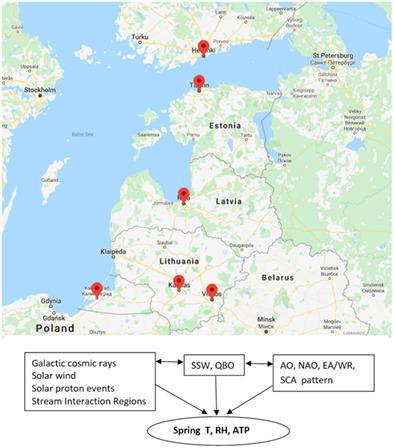当前位置:
X-MOL 学术
›
Int. J. Climatol.
›
论文详情
Our official English website, www.x-mol.net, welcomes your feedback! (Note: you will need to create a separate account there.)
Statistical associations of teleconnection indices and space weather with spring weather pattern in the Eastern Baltic region
International Journal of Climatology ( IF 3.9 ) Pub Date : 2020-10-22 , DOI: 10.1002/joc.6901 Jone Vencloviene 1 , Giedre Kaciene 1 , Deivydas Kiznys 1 , Romualdas Juknys 1
International Journal of Climatology ( IF 3.9 ) Pub Date : 2020-10-22 , DOI: 10.1002/joc.6901 Jone Vencloviene 1 , Giedre Kaciene 1 , Deivydas Kiznys 1 , Romualdas Juknys 1
Affiliation

|
The studies of associations between solar inputs and climate are mostly designed for winter or cold period; whereas the knowledge about these associations during spring on a day‐to‐day time scale are very scarce. Therefore, the aim of this study is to detect the response of spring air temperature (T), relative humidity (RH), and atmospheric pressure (ATP) to variation in teleconnection indices and space weather variables on the day‐to‐day timescale during the period of 1998–2017 in six cities of Eastern part of the Baltic region. We created a multivariate linear regression model for weather variables including month, the linear and seasonal trend, different teleconnection patterns, El Niño–Southern Oscillation, the Quasi‐biennial Oscillation phase, the presence of Sudden Stratospheric Warming (SSW) and space weather variables. The multivariate models for the mean daily weather variables showed a positive association between T and the daily Arctic oscillation, monthly Scandinavian pattern (SCA) indices, solar proton events (SPEs) with a lag of 1–9 days, and solar wind dynamic pressure (P) with a lag of 1–2 days and negative association between T and East Atlantic/West Russia (EA/WR) index. The mean RH positively correlated with a long‐term and short‐term variation in galactic cosmic rays (GCR) and solar wind speed (SWS) with a lag of 0–6 days and negatively correlated with EAWR and NINO3.4 indices. The mean ATP was negatively associated with both long‐term and short‐term changes in GCR and positively associated with the North Atlantic oscillation, EA/WR and SCA indices, By component of interplanetary magnetic field with a lag of 2 days, P, days of Stream Interaction Regions (SIRs) and SWS with a lag of 4–6 days. These results show the significant short‐term effects of SSW, SPEs, SIRs and solar wind variables on spring weather pattern in the Eastern part of the Baltic region.
中文翻译:

波罗的海东部地区遥相关指数和空间天气与春季天气模式的统计联系
研究太阳能输入与气候之间关系的研究主要针对冬季或寒冷时期。然而,在春季以日常时间尺度了解这些关联的知识非常匮乏。因此,本研究的目的是检测春季空气温度(T),相对湿度(RH)和大气压力(ATP)对在每天的时间尺度上遥相关指数和空间天气变量的变化的响应。 1998-2017年期间,波罗的海东部地区的六个城市。我们为天气变量创建了多元线性回归模型,包括月份,线性和季节性趋势,不同的遥相关模式,厄尔尼诺-南方涛动,准两年期涛动阶段,平流层突然变暖(SSW)和空间天气变量的存在。T和每日北极振荡,斯堪的纳维亚模式(SCA)指数,太阳质子事件(SPEs)滞后1–9天以及太阳风动压力(P)滞后1-2天且两者之间呈负相关T和东大西洋/俄罗斯西部(EA / WR)指数。平均相对湿度与银河宇宙射线(GCR)和太阳风速(SWS)的长期和短期变化呈正相关,而滞后时间为0-6天,与EAWR和NINO3.4指数呈负相关。平均ATP与GCR的长期和短期变化均呈负相关,与北大西洋振荡,EA / WR和SCA指数,行星际磁场的B y分量(滞后2天,P)均呈正相关,流交互区域(SIR)和SWS的天数,为4-6天。这些结果表明,SSW,SPE,SIR和太阳风变量对波罗的海东部地区的春季天气模式具有重大的短期影响。
更新日期:2020-10-22
中文翻译:

波罗的海东部地区遥相关指数和空间天气与春季天气模式的统计联系
研究太阳能输入与气候之间关系的研究主要针对冬季或寒冷时期。然而,在春季以日常时间尺度了解这些关联的知识非常匮乏。因此,本研究的目的是检测春季空气温度(T),相对湿度(RH)和大气压力(ATP)对在每天的时间尺度上遥相关指数和空间天气变量的变化的响应。 1998-2017年期间,波罗的海东部地区的六个城市。我们为天气变量创建了多元线性回归模型,包括月份,线性和季节性趋势,不同的遥相关模式,厄尔尼诺-南方涛动,准两年期涛动阶段,平流层突然变暖(SSW)和空间天气变量的存在。T和每日北极振荡,斯堪的纳维亚模式(SCA)指数,太阳质子事件(SPEs)滞后1–9天以及太阳风动压力(P)滞后1-2天且两者之间呈负相关T和东大西洋/俄罗斯西部(EA / WR)指数。平均相对湿度与银河宇宙射线(GCR)和太阳风速(SWS)的长期和短期变化呈正相关,而滞后时间为0-6天,与EAWR和NINO3.4指数呈负相关。平均ATP与GCR的长期和短期变化均呈负相关,与北大西洋振荡,EA / WR和SCA指数,行星际磁场的B y分量(滞后2天,P)均呈正相关,流交互区域(SIR)和SWS的天数,为4-6天。这些结果表明,SSW,SPE,SIR和太阳风变量对波罗的海东部地区的春季天气模式具有重大的短期影响。



























 京公网安备 11010802027423号
京公网安备 11010802027423号